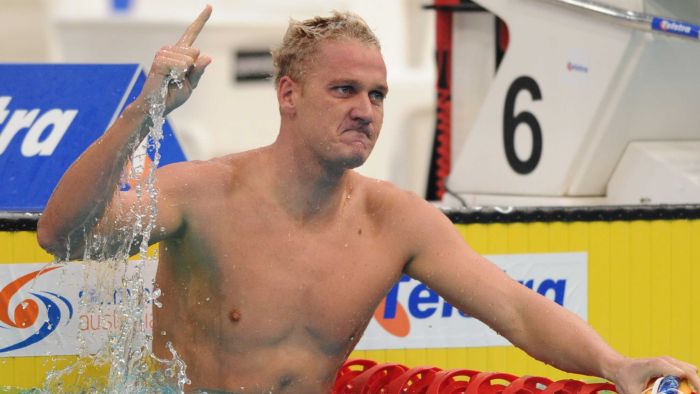Six Australian swimmers are awaiting a decision from the Court of Arbitration for Sport (CAS) to know whether their bronze medals from the men’s 4 x 100 metre medley relay at the 2012 London Olympic Games must be handed back.
The International Olympic Committee re-tested a batch of urine samples taken at the Games and one of those belonged to team member Brenton Rickard.
It came back positive to a diuretic known as furosemide, a banned substance on the World Anti-Doping Code.
In years gone by a threshold of 250nn/ML had to be reached before a test was positive, that threshold has now been erased.
Rickard tested positive to 6 nn/ML. You do not need to be a chemist to understand that it is a very small amount.
Breaststroker Rickard did not swim in the final, but did so in the heat and the rules state if one team member tests positive, the team is disqualified.
If the court considered character witnesses, Rickard could emerge as an athlete with his reputation intact and a finding that, like a growing number of athletes around the world, he has fallen victim to the ever increasing sensitivity of tests that find ever smaller amounts of banned substances ingested through a contaminated product.
Australians used to laugh whenever athletes from elsewhere used contamination as an excuse for not knowing how a banned substance got into the urine or blood sample.
Now it has happened to a second Australian swimmer in a little more than a year.
Shayna Jack flew home from a training camp ahead of last year’s World Swimming Championships in South Korea for personal reasons.
When it emerged later it was because she’d tested positive it caused a sensation around the world because of Australia’s perceived holier than thou attitude to doping.
It also caused a problem for teammate Mack Horton, too, as he had refused to stand on a podium with the Chinese swimmer who had beaten him, Sun Yang.
Sun himself is now serving an eight-year doping ban after losing his own case at the CAS.
A case of unintentional doping?
Either Australia has a doping problem in the same way we accuse other countries of having, or we are seeing evidence of possibly innocent athletes caught in a system that threatens to destroy their reputations.
Once tarred with the ‘drug cheat’ brush, there is little recovery, but there is a growing body of evidence that suggests testing positive does not mean you are an intentional doping cheat.
While the CAS retires to determine Rickard’s fate, and that of the Olympic medals hung in the homes of his teammates, here are some things to consider.
In the most recent WADA Anti-Doping Testing Figures report (2018), there were almost 600 positive tests for diuretics and other masking agents, of those the most common was furosemide — 172 out of 589 positive tests, or 29 per cent of the total.
That does not mean all who tested positive have since been sanctioned — some were false positives and others were covered by legal therapeutic use exemptions.
While some no doubt belonged to intentional cheaters, others belonged to a group who face accusations of taking a banned substance without having any idea how it happened.
Unintentional doping was first recognised as a legitimate problem in 2000, meaning just because you test positive, does not mean you are a cheat.
The Swiss Anti-Doping Lab and the Swiss Federal Office of Sports conducted one of the first studies into the issue.
Since 2003, furosemide detection has been increasing but as the British Journal of Pharmacology warned in a review in 2010, “this trend of increasing positive findings may be due not only to an increase in abuse, but is likely due to improved methods of detection”.
A study conducted by six academics in Spain for the Nutrients Journal in 2017 reported that supplements tested for substances banned by WADA showed contamination rates between 12 and 58 per cent.
The use of supplements is widespread among athletes with one report finding in some sports up to 90 per cent of participants taking at least one supplement a day.
In their book The Anti-Doping Crisis in Sport, academics Paul Dimeo and Verner Moller suggest the adverse effect of more tests, for more substances, with improvements in sensitivity, means “athletes who have never taken a banned substance and never been negligent in a reasonable sense of this word, will have an increasing risk of falling victim to a false positive”.




Contract law specialists also point to the compulsory nature of what is deemed to be an agreement between an athlete and a sport.
Negotiation is not an option.
To play organised sport in Australia, whether you are an elite athlete or an under-6 football player, when you pay your registration fee to the sport’s governing body you have just signed on to the WADA code.
It is unlikely but it is completely within the rights of anti-doping officials to request your school age son or daughter to provide a urine sample next time they compete, with the requirement to strip from the waist down so the observer can see the urine exiting the body.
That will ensure fake urine is not passed from an internal catheter (as some cheats have done).
Nobody wants drug cheats in sport, certainly, but nobody wants innocent athletes branded as such.
Rickard is said to be “distraught” by some who know him well, while Swimming Australia CEO Leigh Russell has offered complete support and former Olympic swimmer Rob Woodhouse described him as one of the most “highly regarded” swimmers internationally.
The CAS will determine whether he remains so or slips into the ever-growing pool of those who failed a test to be forever branded a “drug cheat”.







